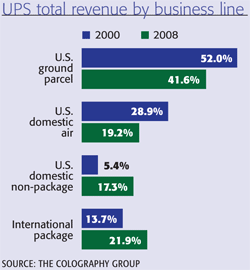Ten years after IPO, Big Brown still trying to deliver
It was a signature event of a signature era. On Nov. 10, 1999, at the height of the dot.com boom, UPS Inc. ended nearly seven decades as a private company and went public with what was, at the time, the largest IPO in U.S. history.
The offering, which raised $5.5 billion, was an immediate hit. Initially priced at $50 a share, UPS's new "Class B" stock—which represented 10 percent of its shares at the time—soared more than $17 by the close of the first day of trading.
It wasn't hard to understand the IPO's appeal. Unlike companies that were coming public with only modest revenues and a scant chance of showing profits anytime soon, UPS was a 92-year-old business with a proven model and an established track record.
 At the same time, UPS was seen as being in the sweet spot of the Internet boom. With its massive
shipping network and sophisticated information systems, UPS was wonderfully positioned to carry the
avalanche of shipments that electronic commerce would spawn, investors thought.
At the same time, UPS was seen as being in the sweet spot of the Internet boom. With its massive
shipping network and sophisticated information systems, UPS was wonderfully positioned to carry the
avalanche of shipments that electronic commerce would spawn, investors thought.
Much has changed since then. In its first decade as a public company, UPS learned several painful lessons. It found it was a far different matter to communicate a message and strategy to a skeptical audience of outside investors and money managers than to its employee base. It discovered that public investors had less patience than its employees for large-scale investments that would not show a return for some time. And it had to embrace the notion that failure to hit quarterly revenue or profit expectations—which in UPS's privately held days might have been greeted with internal shrugs—would be met by widespread share selling by investors whose loyalty didn't extend beyond their stock certificates.
At UPS, the marker for success is, and has always been, the performance of its equity. Here, one statistic speaks volumes: Its stock price is at this writing only about $6 a share above its IPO price in 1999. This has been a blow to employees of a company where individual wealth has been generated by stock ownership instead of base compensation. For long-time employees accustomed to like-clockwork annual returns of 15 percent or more when UPS was private, the adjustment has been that much more painful.
Buying spree
Members of UPS's management committee, the 12-person group that runs the company, were not
available for comment. Interviewed byDC Velocity earlier this year,
Chairman and CEO Scott Davis said the IPO provided needed capital for UPS to make acquisitions supporting its global expansion.
"We needed a publicly traded equity to ensure we had the financial capability to execute on that strategy," said Davis, adding that going public has made UPS "more aggressive, quicker to make tough decisions, leaner, and more competitive."
Since it went public, UPS has made 40 acquisitions totaling an estimated $2 billion. The goal of these transactions has been two-fold: to create an unparalleled worldwide delivery network, and to give customers a one-stop shop of shipping, logistics, and financial service solutions underpinned by advanced information technology.
"When we look at the world, we believe we've won the first race, which is building out our global infrastructure," says UPS spokesman Norman Black. Black notes that UPS's chief rivals, FedEx Corp. and DHL Express, have holes in their respective networks, with FedEx being a weak player in Europe and DHL recently withdrawing from the domestic U.S. market. UPS has a competitive edge because it is a major presence in markets where its competitors are not, Black says.
Once UPS completes work on its intra-China air hub in Shenzhen and an intercontinental air hub in Shanghai, it will essentially have "finished out" its global system, according to Black.
The acquisitions were also designed to support a strategy that would "enable global commerce" by integrating the movement of goods, information, and capital into a seamless flow. UPS believed that if customers leveraged its logistics, information, and financial services to expand their business, they would do more shipping, thus feeding the company's highly profitable small-package operation.
While that strategy was slow to yield results, the plan now seems to be paying off. Business generated by UPS's Supply Chain Solutions unit provides it with about $2 billion in annual small package revenue, according to a 2008 study by consulting firm Armstrong & Associates.
Still, the unit's performance has been a concern for investors. Profit margins for supply chain revenue have remained in the mid-single digits, in contrast to the healthier 15-percent or so margins generated by small package revenues. Black says the company never expected margins from supply chain services to match those from the small package operation. "We believe we can get (supply chain margins) to 7 percent and grow it from there," he says.
Long view
UPS, like other transport logistics companies, has been hammered by the recession. In the second
quarter of 2009, revenues and operating profits were off 16.7 and 38.4 percent, respectively, from
2008 levels. Yet the company's long-held reputation for fiscal prudence has helped cushion the
blows. At the end of June, it had $3.3 billion in cash and marketable securities, and $10.9 billion
in debt, most of it in long-term durations, levels considered reasonable for a company whose sales
are about five times that. In 2008, UPS's revenues hit a record $51.5 billion; it will be
hard-pressed to exceed that mark in 2009.
What makes UPS a formidable competitor is less its sheer size than its capacity to shake up the landscape even after 102 years in business. In early October, it launched an initiative enabling shippers, for a nominal charge, to calculate and offset the carbon footprint of their shipments. UPS also said it will match the cost of the offsets incurred by its customers.
A few days earlier, in a direct attack on the traditional direct-mail industry, the company announced it was testing a service in which drivers deliver small boxes filled with up to 12 premium offers and samples to select consumers. Retailers that have signed up for the pilot program include Bed Bath & Beyond, Zappos.com, and the Men's Wearhouse.
Black says that UPS continues to take the long view toward its business despite short-term market setbacks. That discipline, he says, positions the company well for the day when the global economy gets back on its feet. "The next five to 10 years is going to be a period of tremendous growth," he predicts.
Related Articles

Copyright ©2024. All Rights ReservedDesign, CMS, Hosting & Web Development :: ePublishing